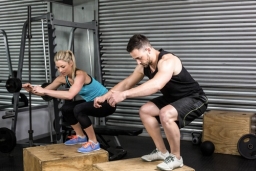Plyometrics – Bridging the Gap between Speed and Strength
Wednesday, July 27, 2016 - 09:30

Plyometric training (often termed jump training or plyos) is a combination of sport-specific exercises that combine power, speed, and strength in order to enhance performance. While this type of training can work for any athlete, sports that have a lot of stopping, starting, frequent changes in direction, sprinting, and jumping will tend to see the most benefits; soccer, volleyball, basketball, baseball, figure skating, and hockey, just to name a few.
Plyometric training is characterized by three phases: an eccentric (lengthening) contraction, a short resting period called the amortization phase, and a powerful concentric (shortening) contraction. In order to get the best results, the time between the eccentric and concentric movements needs to be short.
Safety first - Experts recommend a solid foundational strength and fitness base before incorporating these types of exercises into training.
Start slow - Since plyometric exercises place a large demand on the body, begin with few repetitions and keep the training volume low - once a week to start. Plyos should always be a supplement to your regular workouts and should never be the bulk of your training. Before beginning, ask a coach, trainer, or check out the resources linked for a better idea of proper technique. Good technique minimizes the chances of accidental injury and will ensure you get the most out of your training.
- Throws/Medicine balls - Lift a medicine ball over the head and forcefully throw the ball against a wall. Catch the ball and repeat. Other options include: throwing from the side, pushing the ball into a downward thrust into the ground, or use one arm and throw directly overhead or against a wall. Most of these movements can also be completed with a partner.
- Clap push-ups - Perform a push-up with a clap in between.
- Jump squats - Start in a low squat, jump straight up and land softly in a low squat. Movement should be consecutive and quick.
- Double leg back kicks - From a standing position, jump straight up in the air aiming for maximum height and touch your heels to your buttocks.
- Low hurdles - Hop over small cones or low hurdles, high, with both feet.
One of the nicest things about incorporating plyometric exercises into your schedule is that they require little to no equipment. The most you need is your own body weight, a medicine ball, and a wall that can absorb the repeated damage. Ideally a plyometric workout aims to decrease the time in between eccentric and concentric movements so an athlete can gain strength and power. When done correctly, they add an extra intensity to your regular training.
References:
ÇİMENLİ Ö, KOÇ H, ÇĐMENLİ F, KAÇOĞLU C. Effect of an eight-week plyometric training on different surfaces on the jumping performance of male volleyball players. Journal Of Physical Education & Sport. March 2016;16(1):162-169.
Chu D, Myer G. How Plyometrics Works. Track Coach. Winter2014 2014;(206):6569-6575.
HUNNICUTT J, ELDER C, DAWES J, ELDER A. The Effects of a Plyometric Training Program on Jump Performance in Collegiate Figure Skaters: A Pilot Study. International Journal Of Exercise Science. April 2016;9(2):175-186.
Plyometrics: Basic Training for Life. Running & Fitnews. March 2009;27(2):5-7.
Twist P. Plyometric Progressions for Athletes. IDEA Fitness Journal. March 2009;6(3):27-31.
Zribi A, Zouch M, Tabka Z, et al. Short-Term Lower-Body Plyometric Training Improves Whole-Body BMC, Bone Metabolic Markers, and Physical Fitness in Early Pubertal Male Basketball Players. Pediatric Exercise Science. February 2014;26(1):22-32.
About the Author: Michelle is an information management specialist with many years focusing on sport and fitness research and education. Michelle has been sharing her expertise with SIRC for over 3 years.